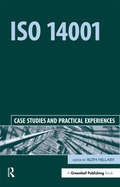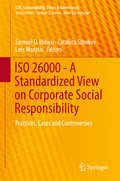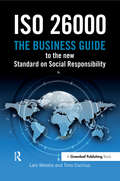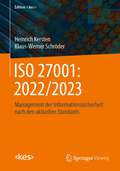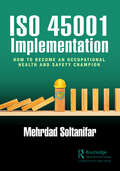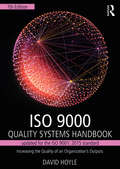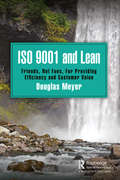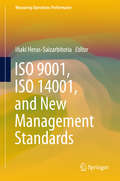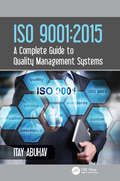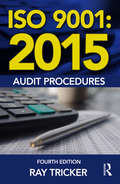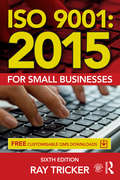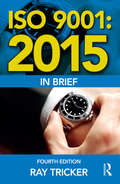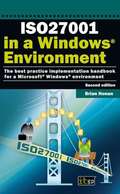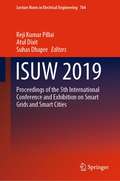- Table View
- List View
ISO 14001: Case Studies and Practical Experiences
by Ruth HillaryISO 14001 is the star standard among the International Organization for Standardization's ISO 14000 series of environmental management standards. It has seen spectacular growth since its launch in September 1996. Worldwide registrations are set to pass the 20,000 mark in 2000 with 20 times that number reportedly waiting in the wings.In 30 explicit but concise chapters, ISO 14001: Case Studies and Practical Experiences seeks to unravel the truth behind what can and cannot be achieved by ISO 14001 and aims to provide readers with enough knowledge to make choices about its relevance and importance not only to their worlds but also to society. Written by leading practitioners, certifiers, consultants, government and academics, the book examines both the real benefits and the shortcomings organizations have experienced with ISO 14001. We learn from both.Far more ambitious than an implementation guide, the book will provide those readers struggling with the standard first-hand experiences of the real issues they will face in implementing their EMS and, just as importantly, what certifiers look for when they visit firms. ISO 14001: Case Studies and Practical Experiences is a warts-and-all expose of ISO 14001: the issues tackled; the problems faced and overcome; and, above all, the astonishing flexibility of its uses and the diversity of its users.This important book is a must for businesses, researchers, consultants, government officials, students, NGOs and support organisations who want more than just another how-to-do-it manual; but rather the truth about how ISO 14001 is really working on the ground.
ISO 26000 - A Standardized View on Corporate Social Responsibility: Practices, Cases and Controversies (CSR, Sustainability, Ethics & Governance)
by Samuel O. Idowu Catalina Sitnikov Lars MoratisThis book provides a comprehensive and detailed introduction to the ISO 26000 standard for social responsibility (SR) in businesses and corporations. In addition to discussing the standard’s focus on various stakeholders and seven core topics, the book underscores its key aspects and most debatable issues, with a focus on its connection to sustainable business practices. It presents numerous cases and practical examples of the ISO 26000’s implementation and discusses the outcomes and lessons learned, in terms of the extent to which organizations can envision practicing CSR in ways that fit their activities, stakeholders and environment. Lately, the ISO 26000 has proved to offer an interesting and important approach to the standardization of (corporate) social responsibility. Approached and perceived as a voluntary standard that does not include any specific requirements, determining the best way to implement and work with it involved a considerable amount of experimentation. This book showcases the current state of application and discusses how different countries have developed their own specific versions of the standard, which organizations can use to certify their SR processes.
ISO 26000: The Business Guide to the New Standard on Social Responsibility (Csr, Sustainability, Ethics And Governance Ser.)
by Lars Moratis Timo CochiusOver the last ten years, Corporate Social Responsibility (CSR) has grown from being criticised as a management fad to being endorsed as good business practice by the majority of the world's leading companies. It has also become ever more complex; and the majority of companies are now in need of clarity and guidance to actively engage with CSR in practice, to develop strategies that reflect the unique context in which each company operates and to embed CSR within their values. ISO, the International Organization for Standardization, began developing an International Standard providing guidelines for social responsibility (SR) in 2005. This long-awaited guidance standard was finally published in November, 2010 as ISO 26000. Developed by stakeholders from industry, government, labour, consumers, non-governmental organizations and others, ISO 26000 will almost certainly become the single most authoritative worldwide standard for SR. In only a few years' time, many thousands of organizations around the world are likely to be using ISO 26000 as a foundation for their SR policies. ISO 26000 is voluntary, and includes no specific requirements; therefore it is not a certification standard. Nonetheless, business users in particular are anxious to measure against the new ISO guideline their current efforts at implementing SR issues within their overall business strategy. Furthermore, many organizations have indicated that they may reformulate current strategies or develop new initiatives based on the content of ISO 26000. This book, written by international experts who have closely followed the development of ISO 26000, is the first to provide potential users with a comprehensive roadmap to the new standard and a compass to identify where they stand in relation to it now. ISO 26000 defines all of the key terminology of SR, provides advice about the ways in which organizations can identify their social responsibilities and how SR can be integrated not only into companies, but into all types of organizations. It is not another code or norm, but an overarching blueprint for social responsibility. This book covers all the key content of ISO 26000, examining the development of the standard, the topics covered and how key themes such as stakeholders are dealt with. It is rich in tools and benchmarking exercises, illustrative material, case examples, and help for companies looking to base their CSR policy on ISO 26000. It also contains an overview of the actions and expectations of organizations that wish to work in accordance with ISO 26000. Timely, detailed and practical, ISO 26000: The Business Guide to the New Standard on Social Responsibility will be an essential resource for the thousands of organizations that need an expert view on how the new standard works, where they stand in relation to it, and how they can work towards developing their CSR efforts in line with its content.
ISO 27001: Management der Informationssicherheit nach den aktuellen Standards (Edition <kes>)
by Heinrich Kersten Klaus-Werner SchröderEin qualifiziertes Management der Informationssicherheit ist heutzutage für jede Organisation unverzichtbar. Die Normenreihe ISO 27000 ist dabei ein anerkannter „Wegweiser“ zu diesem Ziel. Im internationalen Kontext ist ihre Erfüllung für viele Organisationen ein wichtiger Wettbewerbsfaktor. Auch in Deutschland hat diese Normenreihe Eingang in Vorgaben, Regelungen und Gesetze zum Thema Informationssicherheit gefunden.Das vorliegende Buch kommentiert vor diesem Hintergrund die aktuellen Normen ISO 27001 und ISO 27002 (Ausgabe 2022/2023): Nach einer Einführung in die Normenreihe und ihren Fachbegriffen werden die Anforderungen an das Managementsystem für Informationssicherheit (ISMS) detailliert erklärt und mit zahlreichen Hinweise zur Umsetzung versehen. Im Anhang der ISO 27001 sind die sog. Controls aufgeführt, die in der neuen Normfassung komplett umstrukturiert und an vielen Stellen geändert wurden. Das Buch behandelt ausführlich alle Controls und gibt viele Beispiele für ihre Anwendung.Mit dem Erscheinen der neuen Normfassungen müssen sich viele Organisationen entsprechend umstellen – nicht zuletzt auch im Zusammenhang mit Zertifizierungen. Das Buch bietet hier einen ausführlichen Fahrplan zur Migration auf die neuen Normen.
ISO 45001 Implementation: How to Become an Occupational Health and Safety Champion
by Mehrdad SoltanifarOver two million people worldwide die every year due to work-related accidents and illness, which corresponds to over 6000 deaths every day (International Labour Organisation, 2020). Globally, there are about 340 million occupational accidents and 160 million victims of work-related injuries and illness each year (International Labour Organisation, 2020). Occupational health and safety is a major challenge for many organizations. Regardless of the size and nature of their business, organizations should protect their people and provide a safe and healthy working environment. They should identify the potential health and safety risks present in their workplace and take appropriate action to keep their workers free from harm. Occupational safety focuses on potential safety hazards that can cause injury. Occupational health, on the other hand, looks at potential health issues such as occupational medicine, occupational hygiene, and primary health care, including the wellbeing of workers. For organizations that want to implement an occupational health and safety management system based on the ISO 45001:2018 standard but are not familiar with its structure and definitions, it often takes a significant amount of resources to understand the requirements of the standard and plan their implementation. This book provides guidance in establishing an occupational health and safety management system linked to the requirements of ISO 45001:2018. It aims to explain all the requirements of ISO 45001:2018 clause by clause to provide guidance to: • Organizations preparing for ISO 45001:2018 implementation • Individuals who want to build a career in occupational health and safety • Health and safety practitioners and managers who want to improve their occupational health and safety performance • Occupational health and safety consultants who prepare their clients for ISO 45001:2018 certification audits • Internal and external auditors who audit occupational health and safety management systems. In addition to the requirements of the standard, this book includes industry best practices, methods, and techniques to address these requirements. While clarifying each requirement of the standard, it also discusses the steps needed to achieve the requirement, areas that auditors may check, and mandatory or voluntary documents that may be maintained or retained to demonstrate conformity with the requirement.
ISO 9000 Quality Systems Handbook-updated for the ISO 9001: Increasing the Quality of an Organization’s Outputs
by David HoyleCompletely revised to align with ISO 9001:2015, this handbook has been the bible for users of ISO 9001 since 1994, helping organizations get certified and increase the quality of their outputs. Whether you are an experienced professional, a novice, or a quality management student or researcher, this is a crucial addition to your bookshelf. The various ways in which requirements are interpreted and applied are discussed using published definitions, reasoned arguments and practical examples. Packed with insights into how the standard has been used, misused and misunderstood, ISO 9000 Quality Systems Handbook will help you to decide if ISO 9001 certification is right for your company and will gently guide you through the terminology, requirements and implementation of practices to enhance performance. Matched to the revised structure of the 2015 standard, with clause numbers included for ease of reference, the book also includes: Graphics and text boxes to illustrate concepts, and points of contention; Explanations between the differences of the 2008 and 2015 versions of ISO 9001; Examples of misconceptions, inconsistencies and other anomalies; Solutions provided for manufacturing and service sectors. This new edition includes substantially more guidance for students, instructors and managers in the service sector, as well as those working with small businesses. Don’t waste time trying to achieve certification without this tried and trusted guide to improving your business – let David Hoyle lead you towards a better way of thinking about quality and its management and see the difference it can make to your processes and profits!
ISO 9001 and Lean: Friends, Not Foes, For Providing Efficiency and Customer Value
by Douglas MeyerISO 9000 is a comprehensive set of international standards for quality management and quality assurance. These standards ensure that companies effectively document all aspects of their quality management to show transparency and efficiency within all processes. They are not industry specific and pertain to organizations of any size. Continuous improvement is a key facet of the ISO 9001 standard (the particular standard that specifies requirements for a quality management system), but it does not explain how to implement or maintain this improvement. Lean production methodologies surely provide this crucial and tactical information. Adding Lean production methodologies to quality management systems effectively focuses these improvement activities. In the long run, it will save companies much time and money. This book, written in the novel format, discusses the symbiotic relationship between ISO 9001 and Lean as both can be seamlessly integrated. It shows how Lean provides the process improvements that are required by the ISO 9001 quality management system – Lean is crucial for identifying and removing waste from your processes, which ultimately creates greater customer value. In addition, the book shows the crucial financial benefits of this integration. This novel clearly illustrates that these two systems can function effectively is one understands the complex balance of standardization and change. ISO 9001 is clearly controlled and audited while Lean is often empowering, less meticulously audited, and rarely controlled. While presenting interesting characters and interactions, this fictional story embeds real-life manufacturing speak with a message of the importance of successful synergy between Lean practitioners, production leaders, and quality departments.
ISO 9001, ISO 14001, and New Management Standards (Measuring Operations Performance)
by Iñaki Heras-SaizarbitoriaThis book is a comprehensive reference on ISO management system standards and their implementation. The impacts that ISO 9001 and ISO 14001 have had on business performance are analyzed in depth, and up-to-date perspectives are offered on the integration of these and other management standards (e.g. SA8000, ISO/TS 16949). Detailed information is provided on the signaling value of different management standards and on the new ISO standards for management systems, such as ISO 50001 and ISO 45001, relating to energy management and occupational health and safety. The role of audits in ensuring compliance with the standards and achievement of objectives is also carefully considered. The volume examines avenues for further research and emerging challenges. In offering an integrated, holistic perspective on ISO management system standards, this book will have wide appeal for academics, public decision-makers, and practitioners in the field of quality and environmental management.
ISO 9001: 2000 In Brief
by Bruce Sherring-LucasA clear and comprehensive guide to quickly set up a cost-effective Quality Management System Revised and expanded, the new edition of this easy-to-understand guide provides practical information on how to set up a cost-effective ISO 9001:2000 compliant Quality Management System. With comprehensive coverage of the meaning, history and requirements of the current ISO 9000 standard, the book explains how businesses can easily and efficiently satisfy customer requirements for quality control and quality assurance. Four years into the current version of ISO 9001, the new edition of this valuable book incorporates the hard-won experiences of working with the standard, together with direct, accessible and straightforward guidance that is proven to work. New material in this edition covers: • The Application of the Eight Principles of Management • Audit Basics • Compatibility with other Management Systems and Standards • Comprehensive Summary of the ISO 9001:2000 Requirements • Continual Improvement Methods • Guidance on the Six Mandatory Requirements for Written Procedures • Process Improvement Tools - including Six-Sigma Techniques • Process Metrics • Setting of Quality Objectives • The 21 Specific Requirements of Management • The Application of Information Technology in Quality Management
ISO 9001: 2015 - A Complete Guide to Quality Management Systems
by Itay AbuhavWhat is risk based thinking? Do you know how to address risks and opportunities? Did you ever analyzed risks? Are you sure it is that what the ISO 9001 expects? What do you really know about knowledge management? Can you identify the types of knowledge in your organization? How do you maintain knowledge? What is awareness in the eyes of the ISO 9001 Standard? Can you tell the relation between awareness and the effectiveness of the QMS? This book explains in details all the new issues and topics required by the ISO 9001:2015 Standard and gives you the tools and tricks to answer the new requirements. Just read and do. The table of contents in the book are identical to the table of contents of the standard so you can orient yourself quite easily and find the specific advice you are looking for.
ISO 9001: 2015 Audit Procedures
by Ray TrickerRevised and fully, ISO 9001:2015 Audit Procedures describes the methods for completing management reviews and quality audits and describes the changes made to the standards for 2015 and how they are likely to impact on your own audit procedures. Now in its fourth edition, this text includes essential material on process models, generic processes and detailed coverage of auditor questionnaires. Part II includes a series of useful checklists to assist auditors in compiling their own systems and individual audit check sheets. The whole text is also supported with a glossary of terms as well as explanations of acronyms and abbreviations used in quality. ISO 9001:2015 Audit Procedures is for auditors of small businesses looking to complete a quality audit review for the 2015 standards. This book will also prove invaluable to all professional auditors completing internal, external and third party audits.
ISO 9001: 2015 For Small Businesses
by Ray TrickerSmall businesses face many challenges today, including the increasing demand by larger companies for ISO 9001compliance, a challenging task for any organisation and in particular for a small business without quality assurance experts on its payroll. Ray Tricker has already guided hundreds of businesses through to ISO accreditation, and this sixth edition of his life-saving ISO guide provides all you need to meet the new 2015 standards. ISO 9001:2015 for Small Businesses helps you understand what the new standard is all about and how to achieve compliance in a cost effective way. Covering all the major changes to the standards, this book provides direct, accessible and straightforward guidance. This edition includes: down-to-earth explanations to help you determine what you need to enable you to work in compliance with and/or achieve certification to ISO 9001:2015; a contextual explanation of ISO 9001 within the structure of ISO 9000 family of standards; a detailed description of the structure of ISO 9001:2015 and its compliance with Annex SL; coverage of the new requirements for Risk Management and Risk Analysis; a guide to the costs involved in implementing ISO 9001:2015 and advice on how to control costs; an example of a complete, generic Quality Management System consisting of a Quality Manual plus a whole host of Quality Processes, Quality Procedures and Word Instructions; and access to a free, software copy of these generic QMS files to give you a starting point from which to develop your own documentation. This book is also supported with a complete bibliography containing abbreviations and acronyms as well as a glossary of terms. This comprehensive text will provide you and your small business with a complete guide on your way to ISO compliance.
ISO 9001: 2015 In Brief
by Ray TrickerISO 9001: 2015 In Brief provides an introduction to quality management systems for students, newcomers and busy executives, with a user friendly, simplified explanation of the history, the requirements and benefits of the new standard. This short, easy-to-understand reference tool also helps organisations to quickly set up an ISO 9001:2015 compliant Quality Management System for themselves at minimal expense and without high consultancy fees. Now in its fourth edition, ISO 9001:2015 In Brief consists of a number of chapters covering topics like: What is Quality? – An introduction to the requirements and benefits of quality, quality control and quality assurance What is a QMS? – The structure of a Quality Management System and associated responsibilities. Who produces Quality Standards? – An opportunity to see how interlinked the various Standards Bodies are today. What is ISO 9001:2015? - The background to this particular standard, how it has grown and developed over the years and what ‘Annex SL’ is all about. What other standards are based on ISO 9001:2015? – Details of other standards that replicate or are broadly based on ISO 9001:2015. What to do once your QMS is established – Process improvement tools, internal auditing and the road to ISO 9001:2015 certification. This is supported by:Annex A – A summary of the requirements of ISO 9001:2015 - including an overview of the content of the various clauses and sub clauses, the likely documentation required and how these would affect an organization. A cross-reference to the previous ISO 9001:2008 Clauses is also provided as well as a complete bibliography and glossary.
ISO 9001:2000 Quality Registration Step-by-Step
by Fred DobbReview of previous edition: "I recommend this book to all those who are thinking about implementing ISO 9000...because you will enjoy reading it, and will, as Dobb writes, save yourself a lot of money." QUALITY WORLDThis is a tried and tested hands-on manual, with detailed steps to success and simple explanatory notes. The accompanying companion website contains the text of a complete quality manual along with all necessary operating procedures. The book explains why and how to achieve or upgrade to ISO 9001:2000. The proven successful straightforward approach will initially save you money in consultancy fees and will also help you bypass the trial and error stages. In addition to a successful registration or upgrade, you will continually achieve savings by putting in place effective, efficient and economical management systems.Fred Dobb is a Regional Director of CQA, one of the oldest accredited certification bodies, specializing and with particular expertise in the construction industry, but also covering the whole range of manufacturing, service and other industrial and business sectors. He is a Registered Lead Assessor with experience in a plethora of situations; this practical experience is brought to bear in this essentially practical guide.
ISO14001 Step by Step
by Naeem Sadiq Asif Hayat KhanAccessible and professional advice on how to implement an ISO14001 environmental management systemIn the 21st century, business has to take sustainability seriously. As public opinion becomes increasingly concerned about climate change, governments are imposing ever tighter environmental regulations on both industry and the retail sector. By putting in place an environmental management system (EMS), you can ensure you are disposing of your waste in a responsible manner and making the most efficient use of raw materials. This will help you to lower carbon emissions and keep the negative impact of your business on the environment to a minimum. ISO14001 The International Standard The international standard for an EMS is ISO14001. With an EMS certified to ISO14001, you can improve the safety and efficiency of your business operations, and, at the same time, boost customer confidence and reassure your stakeholders. An invaluable step-by-step guide This pocket guide, intended to help you put in place an EMS, is specifically focused on ISO14001. It is designed to enable industry managers, who may be lacking in specialist knowledge, to achieve compliance with the Standard. A step-by-step approach makes the guide easy to follow. The authors, two experienced auditors, are acknowledged experts on environmental management systems, and they have drawn on material from the UK's Environment Agency. The pocket guide will prove invaluable, not only for auditors and trainers, but also for managers across many sectors of industry. Read this guide and learn how to . . . * Achieve compliance with ISO14001 Instead of just telling you, in bureaucratic fashion, what is specified under ISO14001, this user-friendly guide looks at the active steps you can take in order to ensure compliance with the Standard. It discusses the factors you need to consider when defining the objectives of the EMS, such as financial viability and available technology, and offers suggestions for measuring and monitoring the effectiveness of your environmental policy. * Manage environmental risks The Deepwater Horizon oil spill is an example of the financial and reputational risks associated with environmental pollution. This pocket guide contains sound advice on the types of operational controls you need to put in place to manage environmental risks and help avoid incidents. * Prepare to deal with an emergency The pocket guide offers suggestions on how to plan for an emergency, such as a spillage or a gas leak, ensuring you have procedures in place to minimise the environmental impact. * Improve the image of your brand Ultimately, organisations aim to operate in a way that shows respect for the environment. Certification to ISO14001 is a recognised measure of that commitment. It is in the interests of your business to be well regarded by the public and, if you use this guide to help secure compliance with ISO14001, you can improve public perception of your organisation. Investing in ISO14001 certification can contribute to enhanced brand equity.
ISO27000 and Information Security: A Combined Glossary
by Steve G Watkins Alan CalderGet to grips with key ISO27000 and information security vocabulary with this indispensable, concise pocket guide! Information security is of crucial importance to your business. If you don t know the difference between a cookie and a worm, or between war-chalking and digital watermarking, you are sure to find this guide enlightening. The strength of the book is that it is a combined glossary, enabling you to find explanations of geek slang, procedural language and acronyms all in one place. The combined glossary is a revised edition of the popular A Dictionary of Information Security Terms, and this new edition has been able to draw on the definitions provided in ISO/IEC 27000:2009 Security Techniques Information security management systems Overview and vocabulary. What's new? Further definitions are sourced from ISO/IEC Guide 73:2002 to provide you with authoritative explanations of those information security terms that are used across the ISO framework. The combined glossary has taken account of an important change on the information security scene, and contains some new acronyms and definitions from the Payment Card Industry Data Security Standard (PCI DSS). Benefits to business include: * Understand what everyone else is talking about The fact that you re reading this suggests you take an interest in information security. Whether you work in business or in the public sector, it s an issue that s likely to come up. If you re given a position paper to read on information security, or have to attend a briefing, you will want to form your own opinion, particularly when the discussion directly affects your company. Meekly accepting arguments you don t understand is never a good idea, especially not when large sums of money are involved. With the clear, reliable definitions contained in this combined glossary, you can finally get to grips with the problem. * Understand what you re talking about Any modern organisation relies on its IT systems. Although IT may not be your speciality, cybercrime affects all of us. So, wherever you work, if you are in a position of responsibility, then at some point, you will need to form a view on information security and put your point across. You can use this combined glossary to bring your arguments into sharper focus. The pocket guide will prove invaluable not only to business executives but also to civil servants and lawyers, as well as to people working in financial services and the media. * Assist ISO implementation If your company or department is introducing an information security management system (ISMS) as specified under ISO27001, then you can ensure that key personnel are up to speed on the issue of information security by giving them all a copy of this pocket guide. * Make better decisions The bad guys are only ever a mouse-click away. If you care at all about the financial well-being of your company, you need to take action on information security. However, there is often a gap between management s overall sense of its responsibilities regarding information security and the IT people whose technical skills are required to fulfil those obligations. This combined glossary will help your organisation to bridge that gap and to facilitate communication between managers and the IT department. The guide enables managers to grasp the key concepts of information security, thereby facilitating the planning and coordination that are essential for successful implementation of any major information security project. So it makes sense to take information security seriously, even if you are not an expert on the subject. This rapidly evolving discipline has spawned a complex and bewildering vocabulary and understanding the terms and language will stand you in good stead. If you have ever felt confused by the language of information security, this pocket guide is for you; designed for non-specialist managers and those who are new to the subject, two internationally recognised experts in the field of information security have created a simple key to the mysteries of geek speak.
ISO27001 / ISO27002 A Pocket Guide
by Alan CalderISO/IEC 27001:2005 is an international standard for information security management systems (ISMSs). Closely allied to ISO/IEC 27002:2005 (which used to be known as ISO17799), this standard (sometimes called the ISMS standard) can help organizations meet all their information-related regulatory compliance objectives and can help them prepare and position themselves for new and emerging regulations. Information is the lifeblood of modern organizations and, therefore, ensuring that information is simultaneously protected and available to those who need it is essential to modern business operations. Information systems are not usually designed from the outset to be secure. Technical security measures and checklists are limited in their ability to protect a complete information system. Management systems and procedural controls are essential components of any really secure information system and, to be effective, need careful planning and attention to detail. ISO/IEC 27001 provides the specification for an information security management system and, in the related Code of Practice, ISO/IEC 27002, it draws on the knowledge of a group of experienced information security practitioners in a wide range of significant organizations across more than 40 countries to set out best practice in information security. An ISO27001-compliant system will provide a systematic approach to ensuring the availability, confidentiality and integrity of corporate information. The controls of ISO27001 are based on identifying and combating the entire range of potential risks to the organizations information assets. This helpful, handy ISO27001/ISO27002 pocket guide gives a useful overview of these two important information security standards.
ISO27001 in a Windows® Environment
by Brian HonanA fundamental title that should be part of every information security practitioner''s technical library!The vast majority of ISO27001 implementations will, to one extent or another, take place in a Windows environment. ISO27001 project managers are not always Microsoft technical experts, but a large number of the ISO27001 controls require a technical implementation. Bridging the gap between non-technical ISO27001 project managers and IT specialists, this book explains what the controls are, and describes how to implement them in a Windows environment, equipping the ISO27001 project manager to succeed with the implementation. MCSEs who have security training (MCSE Security), but who may not understand the ISO27001 approach to selecting and implementing controls, will also benefit from this book. It provides them with the necessary rationale and links their technical understanding of Microsoft information security controls into the international best practice framework for information security. This book should be a core part of the technical library of every MCSE and information security practitioner. If you have a CISSP, CISM, GIAC, or another professional certification, you should read this book. Covering best practice implementation over a wide range of Windows® environments, this second edition is completely up to date for Windows® 7 and Server® 2008. Benefits to business include: * Enable successful implementation Although ISO27001 project managers are seldom Microsoft technical experts, a large number of the ISO27001 Annexe A controls demand a technical implementation. Now, thanks to this book, project managers can finally give a clear explanation to their technical people of what is required under ISO27001. Armed with this guide, a project manager will find it much easier to succeed with implementation of ISO27001 * Help security engineers to understand ISO27001 ISO27001 is the international best practice framework for information security. However, because ISO27001 takes a business risk approach, it is unfamiliar territory to many Microsoft Certified Systems Engineers (MCSEs), even if they already have security training (MCSE Security). With this book, MSCEs can fill a gap in their knowledge and thereby harness their technical understanding of the Microsoft information security controls to drive through implementation of ISO27001 * Improve security and reliability. The purpose of ISO27001 is to ensure the confidentiality, integrity and availability of your business information. By putting suitable controls in place you can achieve these "CIA" goals. In this way you will also make your storage and handling of data more reliable * Take advantage of the tools you already have to hand. Since Microsoft products are so widely used, the technical details in this book are based on the Microsoft Windows® platform. This book shows IT managers how to make effective use of the Microsoft technologies at their disposal to support implementation of ISO27001. As a result, your organisation should be able to achieve certification without having to buy additional third-party software. Security improvements from MicrosoftMicrosoft''s latest desktop operating system, Windows® 7, comes with many security improvements. You can use these to help you to develop an ISMS that complies with ISO27001. One of these features is BitLocker, an encrypting system that allows you to encrypt individual files and folders. You can also encrypt the entire contents of a computer''s hard disk to make the data stored on it unavailable to unauthorised personnel. BitLocker To Go enables you to transport information securely from one system to another using portable devices such as a USB. Another feature of Windows 7, AppLocker, will allow your organisation to restrict the applications available to a user on a desktop. By preventing improper use of key applications by your staff, AppLocker can help your organisation to reduce security risks. This guide provides the IT manager with a detailed breakdown of the various controls requir...
ISRO: Explore Space or Exploit CubeSats?
by Tarun Khanna Rachna Tahilyani Karim R. Lakhani Prithwiraj ChoudhuryCase
ISRO: Explore Space or Exploit CubeSats?
by Tarun Khanna Rachna Tahilyani Karim R. Lakhani Prithwiraj ChoudhuryThe Indian Space Research Organization (ISRO) achieved global acclaim by launching successful missions to the moon and Mars at a fraction of the cost of prior Western missions. It is now faced with an important strategic dilemma-whether to continue exploring deep space in collaboration with NASA and other leading agencies, whether to leverage its infrastructure for societal uses, or whether to exploit a commercial opportunity related to launching small, handheld cubesats. The case explores the basis for ISRO's cost advantage vis- -vis western entities, as well as its resource constraints and human capital considerations as it makes this important strategic choice for the future.
ISS A/S (D): Goldman's 2011 Business Standards Report
by Clayton RoseThe (D) case describes aspects of the Jan 2011 report by the Goldman Sach's Business Standards Committee on how the firm might strengthen its practices with respect to clients and other stakeholders.
ISS A/S: The Buyout
by Lucy White Clayton Rose Carsten BienzProvides the opportunity to value a leveraged buy-out; and to examine the nature and extent of a company's responsibilities to its bondholders. Here, the context is a "going private" transaction in Europe, where the financing plan called for the addition to the company's balance sheet of a significant amount of new debt and a reshaping of the capital structure. While leveraged buyouts had been used in Europe for several years, this was likely the first LBO done with a company that had publicly traded investment grade debt outstanding. The increased debt from the deal would increase the risk to the company and to the existing bonds, and the bonds' prices would fall significantly as a result. Students can use discounted cash flow techniques to value the LBO. They can then consider the wisdom of undertaking the LBO at the offered price, and work out a sensible debt schedule for the company. Students must also evaluate the effect of the transaction on the existing bonds, and understand the principles governing contractual duties (and how they differ from fiduciary obligations) towards bondholders (accounting for a business and social culture outside the United States) in order to determine the best course of action for the private equity buyers.
ISUW 2019: Proceedings of the 5th International Conference and Exhibition on Smart Grids and Smart Cities (Lecture Notes in Electrical Engineering #764)
by Reji Kumar Pillai Atul Dixit Suhas DhapreThis book presents selected articles from INDIA SMART UTILTY WEEK (ISUW 2019), which is the fifth edition of the Conference cum Exhibition on Smart Grids and Smart Cities, organized by India Smart Grid Forum from 12-16 March 2019 at Manekshaw Centre, New Delhi, India. ISGF is a public private partnership initiative of the Ministry of Power, Govt. of India with the mandate of accelerating smart grid deployments across the country. This book gives current scenario updates of Indian power sector business. It also highlights various disruptive technologies for power sector business.
